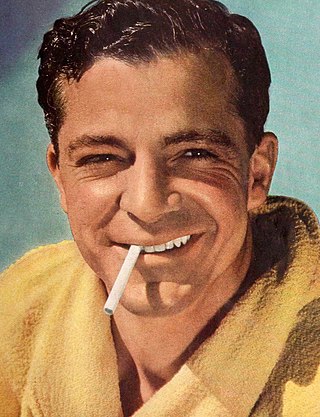
Carver Dana Andrews was an American film actor who became a major star in what is now known as film noir. A leading man during the 1940s, he continued acting in less prestigious roles and character parts into the 1980s. He is best known for his portrayal of obsessed police detective Mark McPherson in the noir Laura (1944) and his critically acclaimed performance as World War II veteran Fred Derry in The Best Years of Our Lives (1946).

Jeanne Elizabeth Crain was an American actress. She was nominated for an Academy Award for Best Actress for her title role in Pinky (1949). She also starred in the films In the Meantime, Darling (1944), State Fair (1945), Leave Her to Heaven (1945), Centennial Summer (1946), Margie (1946), Apartment for Peggy (1948), A Letter to Three Wives (1949), Cheaper by the Dozen (1950), People Will Talk (1951), Man Without a Star (1955), Gentlemen Marry Brunettes (1955), The Fastest Gun Alive (1956), and The Joker Is Wild (1957).

George Chakiris is an American actor. He is best known for his appearance in the 1961 film version of West Side Story as Bernardo Nunez, the leader of the Sharks gang, for which he won both the Academy Award for Best Supporting Actor and the Golden Globe Award for Best Supporting Actor – Motion Picture.
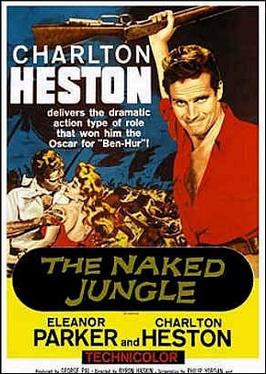
The Naked Jungle is a 1954 American adventure film directed by Byron Haskin, and starring Charlton Heston and Eleanor Parker. Telling the story of an attack of army ants on a Brazilian cocoa plantation, it was based on the 1937 short story "Leiningen Versus the Ants" by Carl Stephenson.

Sam Katzman was an American film producer and director. Katzman's specialty was producing low-budget genre films, including serials, which had disproportionately high returns for the studios and his financial backers.
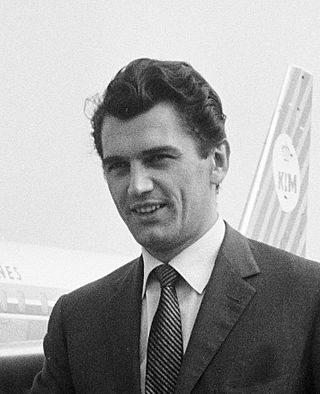
Edmund Anthony Cutlar Purdom was an English actor, voice artist, and director. He worked first on stage in Britain, performing various works by Shakespeare, then in America on Broadway and in Hollywood, and eventually in Italy. He is perhaps best known for his starring role in 1954's historical epic The Egyptian.
Edward Small was an American film producer from the late 1920s through 1970, who was enormously prolific over a 50-year career. He is best known for the movies The Count of Monte Cristo (1934), The Man in the Iron Mask (1939), The Corsican Brothers (1941), Brewster's Millions (1945), Raw Deal (1948), Black Magic (1949), Witness for the Prosecution (1957) and Solomon and Sheba (1959).

Bella Darvi was a Polish film actress and stage performer who was active in France and the United States.

Hot Rods to Hell is a 1967 American suspense film, the last by director John Brahm. The film was based on a 1956 Saturday Evening Post story by Alex Gaby, "52 Miles to Terror", which was the working title of the film.

Betrayed is a 1954 American Eastmancolor war drama film directed by Gottfried Reinhardt and starring Clark Gable, Lana Turner, Victor Mature, and Louis Calhern. The screenplay was by Ronald Millar and George Froeschel. The musical score was by Walter Goehr and Bronislau Kaper, and the cinematography by Freddie Young. The picture, Gable's last for Metro-Goldwyn-Mayer, was filmed on location in the Netherlands and England, and was based on the story of turncoat Dutch resistance leader Christiaan Lindemans, also known as "King Kong". The supporting cast features O. E. Hasse, Wilfrid Hyde-White, Ian Carmichael, Niall MacGinnis, and Theodore Bikel. Betrayed was the fourth and final movie in which Gable played opposite Turner, and their third pairing set during World War II.
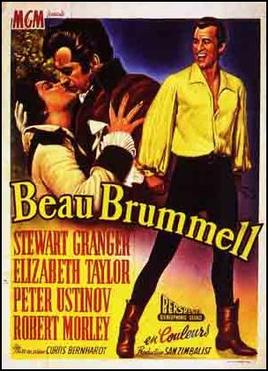
Beau Brummell is a 1954 British historical film released by Metro-Goldwyn-Mayer. It was directed by Curtis Bernhardt and produced by Sam Zimbalist from a screenplay by Karl Tunberg, based on the 1890 play Beau Brummell by Clyde Fitch. The play was previously adapted as a silent film made in 1924 and starring John Barrymore as Beau Brummell, Mary Astor, and Willard Louis as the Prince of Wales.

I Was Monty's Double is a 1958 film produced by the Associated British Picture Corporation and directed by John Guillermin. The screenplay was adapted by Bryan Forbes from the autobiography of M. E. Clifton James, an actor who pretended to be General Bernard Montgomery as a decoy during World War II.

Robin Hughes was a British film and television actor.

Woman's World is a 1954 American CinemaScope and print by Technicolor drama film about corporate America directed by Jean Negulesco and starring Clifton Webb, June Allyson, Van Heflin, Lauren Bacall, Fred MacMurray, Arlene Dahl and Cornel Wilde. The screenplay concerns three men who compete for the top job at a large company.

Something for the Birds is a 1952 American comedy film directed by Robert Wise and starring Victor Mature, Patricia Neal and Edmund Gwenn.

Star of India is a 1954 British-Italian swashbuckling adventure film directed by Arthur Lubin and starring Cornel Wilde, Jean Wallace, Herbert Lom, and Walter Rilla. It was shot at the Riverside Studios in London and on location in Aosta. The film's sets were designed by the art director Cedric Dawe. It was released in the United States in April 1956 by United Artists.

Timbuktu is a 1959 American black-and-white adventure film directed by Jacques Tourneur and starring Victor Mature and Yvonne de Carlo. It is set in Timbuktu (Africa), but was filmed in the Coral Pink Sand Dunes State Park in Kanab, Utah.
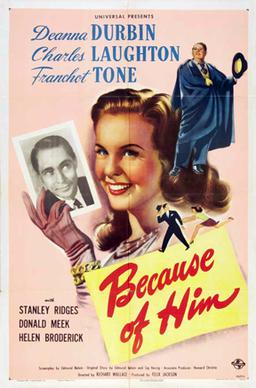
Because of Him is a 1946 American romantic comedy film directed by Richard Wallace and starring Deanna Durbin, Charles Laughton and Franchot Tone.
Michael Mataka is notable in making history as the first native African to become commissioner of the Zambian police. He also had a featured role in George Marshall directed film Duel in the Jungle.
Tony Owen was an American agent and producer, who was married to Donna Reed.

















